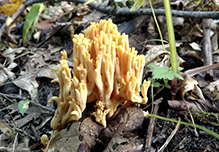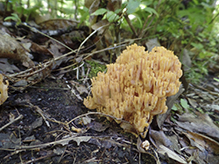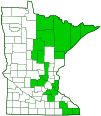Yellow-tipped Coral Fungus
(Ramaria formosa)
Conservation • Description • Habitat • Ecology • Distribution • Taxonomy
Conservation Status |
|
|||||||
| IUCN Red List | not listed |
|||||||
| NatureServe | NNR - Unranked |
|||||||
| Minnesota | not listed |
|||||||
Description |
||
Yellow-tipped Coral Fungus is a distinctive, medium-sized to large coral fungus. It occurs in Europe, Japan, and North America. In the United States it occurs east of the Great Plains and west of the Rocky Mountains, and there is a disjunct population from central Colorado to northern New Mexico. It is not uncommon in eastern Minnesota but it is absent from the western half of the state. It is found in woodlands in summer and fall, alone, scattered, in groups but not clustered (gregarious), and sometimes in rings. It grows on the ground usually under hardwoods but occasionally under conifers. It has a mutually beneficial relationship (mycorrhizal) with the tiny rootlets of trees, absorbing sugars and amino acids while helping the tree absorb water. The fruiting body is 2¾″ to 8″ (7 to 20 cm) tall and 1¼″ to 6″ (3 to 15 cm) wide. The base is usually well developed, fleshy, branched, white toward the bottom, and colored like the branches above. The main branches are well separated and have many upright smaller branches, so that the fruiting body appears to be a cluster of many smaller fruiting bodies. When they first appear, the upper branches are mostly erect, smooth or grooved, and branched again. They may be coral pink, salmon colored, pinkish-orange, or pinkish-tan. The tips may be yellow or colored like the branches. As it ages, the color changes first to pink then to orange, and the tips become yellow and translucent. On older specimens the branches are yellowish-tan, and they have yellowish-tan tips. Spores are produced by cells (basidia) lining the outer surface of the upright branches. The flesh of the base is whitish to pinkish, soft, and brittle near the base. It is not gelatinous. The fruiting body is said to be edible when cooked after the tips have been removed. However, some populations are toxic, so eating is not recommended. The spore print is yellowish, orangish, or brownish-yellow (ochraceous). |
||
Similar Species |
||
Habitat and Hosts |
||
Woodlands Hardwoods and occasionally conifers |
||
Ecology |
||
Season |
||
Summer and fall |
||
Distribution |
||||
|
Sources |
|||
| 2/3/2023 | ||||
Occurrence |
||||
Not uncommon |
||||
Taxonomy |
|||
| Kingdom | Fungi (Fungi) | ||
| Subkingdom | Dikarya | ||
| Phylum | Basidiomycota (Basidiomycete Fungi) | ||
| Subphylum | Agaricomycotina (Higher Basidiomycetes) | ||
| Class | Agaricomycetes (Mushrooms, Bracket Fungi, Puffballs, and Allies) | ||
| Subclass | Phallomycetidae | ||
| Order | Gomphales | ||
| Family | Gomphaceae | ||
| Genus | Ramaria (coral fungi) | ||
The name Ramaria formosa has been applied to a number of similar species in the past. In the eastern U.S. it grows mostly under hardwoods but also conifers, while in the west it grows mostly under conifers but also hardwoods. Some populations are mildly poisonous, while others are not. As currently described, Ramaria formosa may be a group of two or more distinct species. |
|||
Synonyms |
|||
Clavaria formosa Corallium formosum Merisma formosum Ramaria neoformosa |
|||
Common Names |
|||
Beautiful Clavaria Handsome Clavaria Pink Coral Fungus Yellow-tipped Coral Fungus |
|||
Glossary
Mycorrhizal
A symbiotic, usually beneficial relationship between a fungus and the tiny rootlets of a plant, usually a tree.
Visitor Photos |
|||||
Share your photo of this fungus. |
|||||
| This button not working for you? Simply email us at info@MinnesotaSeasons.com. Attach one or more photos and, if you like, a caption. |
|||||
Luciearl |
|||||
 |
|||||
 |
 |
||||
MinnesotaSeasons.com Photos |
|||||
|
|||||

Visitor Videos |
|||
Share your video of this fungus. |
|||
| This button not working for you? Simply email us at info@MinnesotaSeasons.com. Attach a video, a YouTube link, or a cloud storage link. |
|||
Other Videos |
|||
| OPREZ GLJIVARI!!! Otrovna capica, Ramaria formosa GLJIVE iz prirode -Wild mushrooms |
|||
About
Jun 1, 2021 OTROVNA GLJIVA! Može lako da se pomeša sa jestivom capicom. Google Translate: It can easily be confused with an edible cap. Ako želite pomoći kanal možete donirati na Patreonu; https://www.patreon.com/user?u=48941964 |
|||
| Ramaria formosa Antonio Memoli |
|||
About
May 20, 2019 |
|||
| Coral Fungi (Ramaria formosa?) Close-up Carl Barrentine |
|||
About
Sep 11, 2010 Photographed at the Concordia Language Villages, Bemidji, Minnesota (08 September 2010). Go here to learn more about Ramaria: http://www.mushroomexpert.com/ramaria_formosa.html |
|||

Created: 2/3/2023
Last Updated:





